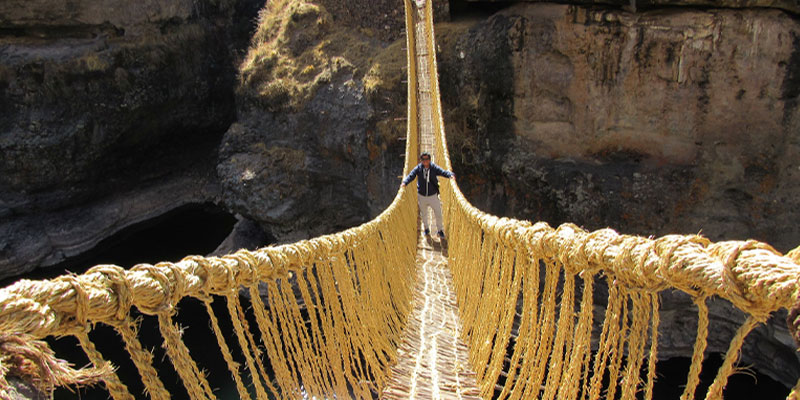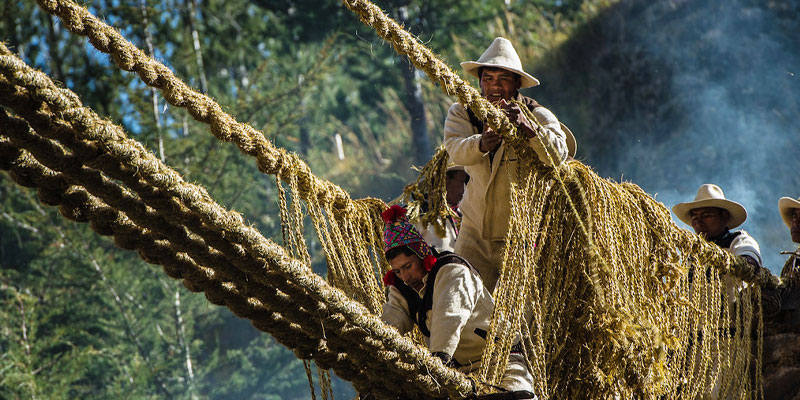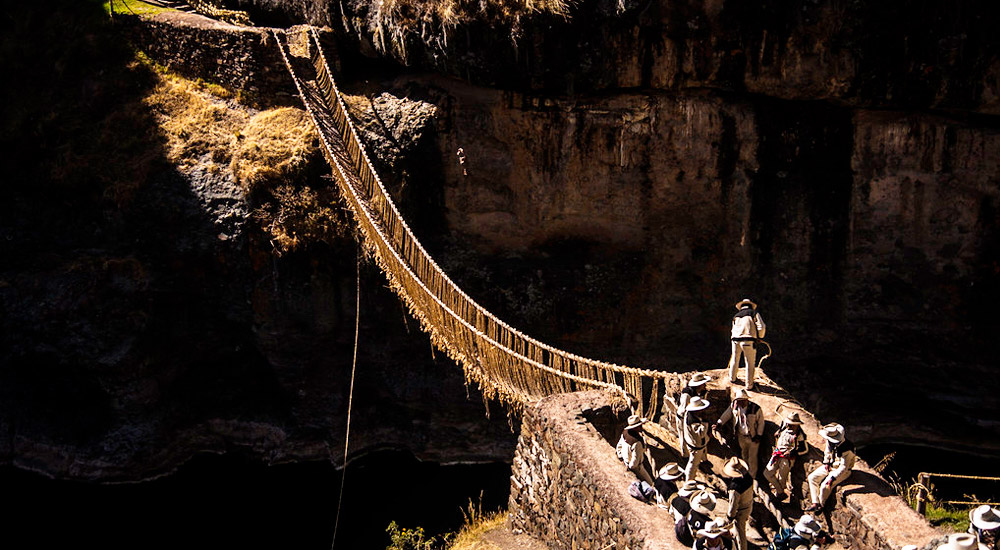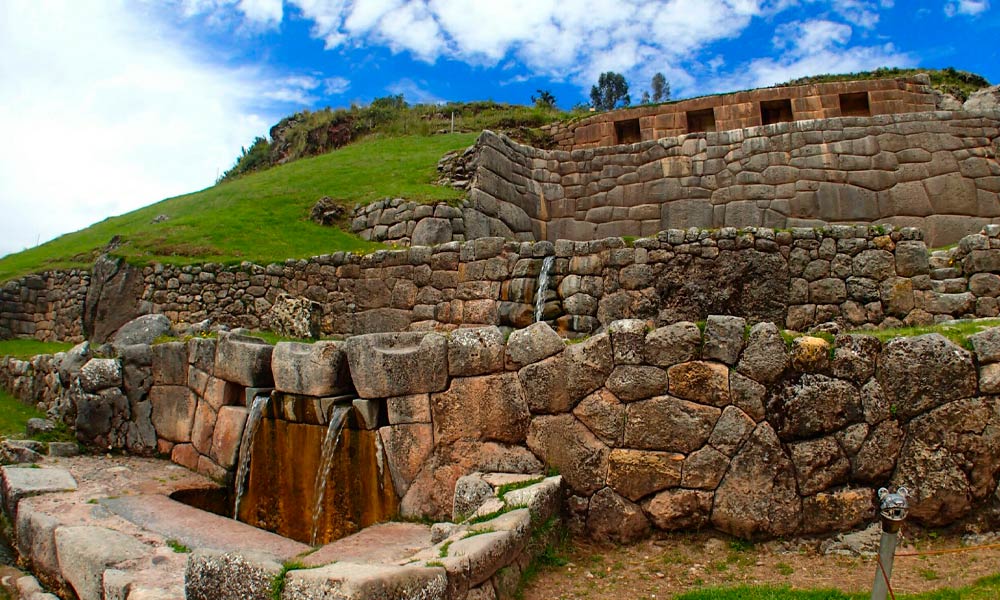Hidden in the heart of Peru, the Q’eswachaka Inca Bridge stands as an awe-inspiring testament to the engineering ingenuity of the Inca civilization. In a world of steel and concrete, this bridge, meticulously woven from ichu grass, continues to span the mighty Apurimac River, connecting communities and cultures across deep canyons and centuries. In this comprehensive guide, we embark on a journey to uncover the rich history, cultural significance, and breathtaking beauty of the Q’eswachaka Bridge, one of the last remaining Inca rope bridges in existence.
The Q’eswachaka inca Bridge: An Ancient Marvel

The Q’eswachaka inca Bridge stands as a testament to the extraordinary legacy of the Inca Empire, representing both their engineering ingenuity and profound cultural significance. This suspension bridge is not merely a static structure; it’s a living embodiment of tradition and community cooperation. Every year, local communities in the Quehue District come together to meticulously handweave this remarkable bridge, a practice that has been handed down through countless generations. The intricate process begins with the careful harvesting of ichu grass, a robust and fibrous plant that thrives in the Andean highlands. The gathered ichu is then skillfully braided into massive cables, meticulously intertwined to form the very sinews of the bridge. It’s a labor-intensive effort that unites these communities in a collective endeavor, weaving not only the physical structure of the bridge but also the bonds of their shared heritage and communal strength.
A Vital Connection: Location and Access
Nestled in the southern highlands of Peru, the Q’eswachaka inca Bridge spans the Apurimac River, connecting four Quechua communities: Huinchiri, Chaupibanda, Choccayhua, and Ccollana Quehue. To reach this remarkable site, you can embark on a scenic drive from Cusco, Peru’s historic capital, to the Quehue District. The journey takes you through the picturesque Andean landscape, offering glimpses of rural life and stunning vistas of the surrounding mountains.
Upon arriving in Quehue, you’ll hike to the bridge’s location, an approximately one-hour trek through rolling hills and rugged terrain. As you approach the bridge, you’ll hear the distant sound of rushing water, a reminder of the mighty Apurimac River below.
A Test of Courage: Crossing the Q’eswachaka
Crossing the Q’eswachaka inca Bridge is a thrilling experience. Its swaying, undulating motion underfoot can be both exhilarating and unnerving. Yet, this unique bridge has withstood the test of time, a testament to the craftsmanship and knowledge of the Quechua people who have maintained this tradition.

Local experts carefully inspect the bridge’s integrity before the annual renewal event known as “Q’eswachaka Festival.” During this event, the bridge is ceremonially renewed by the local communities, a process that has been repeated for over 600 years. The ritual involves replacing the main cables and floor planks, ensuring the bridge remains strong and reliable.
Q’eswachaka Festival: A Celebration of Culture
The Q’eswachaka Festival, a vibrant celebration held annually in June, stands as a spirited homage to Andean culture and its deep-rooted heritage. This remarkable event offers visitors a unique opportunity to witness the bridge renewal process up close, allowing them to gain a profound appreciation for the ancient techniques that have been faithfully passed down through the generations.

As you immerse yourself in the festivities, you’ll be surrounded by a kaleidoscope of colors as locals don their traditional clothing, each piece meticulously handcrafted and laden with cultural symbolism. The air is filled with the enchanting melodies of indigenous music, and the ground reverberates with the rhythmic beats of traditional dances. But perhaps the most captivating aspect of the Q’eswachaka Festival is the palpable sense of pride and unity that pervades the community. As you participate in this extraordinary cultural celebration, you’ll not only witness history coming to life but also become an integral part of a living and breathing testament to the enduring spirit of Andean traditions included Ayahuasca ceremonies. It’s an immersive experience that will leave you with lasting memories and a deep respect for the rich tapestry of Andean culture.
Preservation Efforts and Sustainability
The Q’eswachaka inca Bridge, while an enduring testament to Inca engineering brilliance, grapples with modern-day challenges. The advent of modern transportation infrastructure in the region has somewhat diminished the bridge’s practical significance as a vital crossing point. Today, its existence hinges largely on the dual pillars of tourism and cultural preservation.
In response to these challenges, a harmonious collaboration has emerged between dedicated organizations and local communities. Together, they form a dynamic alliance committed to safeguarding the bridge’s legacy and ensuring its continued existence. Their efforts encompass a multifaceted approach that goes beyond mere maintenance. It embraces cultural preservation, environmental sustainability, and community empowerment.
Visiting Q’eswachaka: Practical Tips
Acclimatization: As with many Andean destinations, acclimatization is essential when visiting Q’eswachaka due to its high elevation. Spend a few days in Cusco or a lower-altitude area to adjust to the thinner air.
Footwear: Wear sturdy hiking shoes with good traction, as the terrain can be uneven and challenging.
Weather: Be prepared for varying weather conditions. Dress in layers, bring a waterproof jacket, and carry sunscreen and a hat.
Respect Local Customs: When attending the Q’eswachaka Festival or interacting with local communities, show respect for their customs and traditions.
Sustainability: Support sustainable tourism practices by respecting the environment, not leaving any waste behind, and following the guidance of local guides and authorities.
Visiting the Q’eswachaka inca Bridge offers a unique opportunity to step back in time and witness the enduring traditions of the Quechua people. It’s a journey that connects you not only with a remarkable feat of engineering but also with the rich cultural tapestry of the Andes. As you traverse this ancient rope bridge, you’ll find yourself not just crossing a river but bridging the gap between centuries of history and the vibrant traditions of modern Peru. Enjoy your journey to this remarkable Inca treasure!










